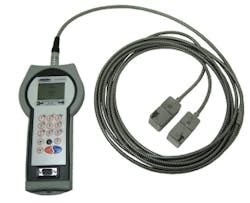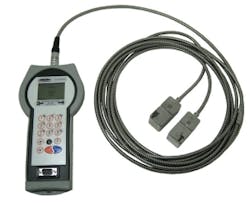New Meter Accurately Monitors Flow in Partially Full Pipe
Some people look at the glass half full, some look at it as half empty. Neither approach is inherently bad, it's just two different ways of looking at things.
However, if a pipe in a wastewater treatment plant is only 50% filled, it doesn't matter whether you call it half full or half empty. When it comes to measuring the liquid in that pipe, either way presents a significant problem. The dilemma comes down to one undisputed truth: few instruments can accurately measure the level of flow in a pipe that is half full - or less.
Primnath Rambissoon, instrumentation supervisor at the Back River Wastewater Treatment Plant in Baltimore, was all too familiar with this issue.
"We had a process in the plant that had been shut down for quite awhile, and when we restarted it, we had problems taking the measurement in that pipe," said Rambissoon, who is also in charge of the plant's remote pumping stations and remote media stations. "It was an application where the flow rate was very low and the pipe wasn't completely full. Unfortunately, the flowmeter we were using was simply unable to measure flow when it was that low."
The trouble area was a section of piping that served as part of the plant's sludge handling process, transferring liquid from one section of the plant to another. The root cause was that the 12-inch pipe was oversized for the amount of material running through it: plant management had previously attempted to remedy the situation by installing a reducer to reduce the pipe from 12 inches to 8 inches, but that still wasn't enough to make the existing flowmeter work.
"When I came here about three years ago, operations told me about it, but there was nothing I could really do without a full pipe to read," said Rambissoon. "It would just run and they would look at it when they got flow and they would just guess much of the time.
"What's worse, since we couldn't get a flow, we couldn't operate on automatic mode in that process, which would have reduced our operational costs. We operated in manual mode for years, probably from the time the system was designed."
According to Rambissoon, the flow measurement in this section of the plant didn't present any environmental or health dangers. At worst, it might lead to a situation in which tanks might be overfilled, causing leakage somewhere else in the plant. Still, accurate measurement was important to the plant's overall efficient operation.
The Krohne Tidalflux Electromagnetic Flowmeter is being used to monitor flow in a partially full pipe at the Back River Wastewater Treatment Plant.
Late in 2008, David Spitzer of Krohne Inc. was making one of his regular sales calls to Back River. At the time Spitzer was the company's district sales manager for Maryland, Washington, DC, Virginia, and parts of Delaware. He informed Back River that Krohne had a meter capable of measuring flow in partially filled pipes.
"I did a little 'show and tell' on our meter products and it really clicked with Primnath," Spitzer said. "He was very interested in getting our flow meter into that low-flow pipe to see what it could do."
As a result of Spitzer's presentation, Back River bought the Krohne Tidalflux Electromagnetic Flowmeter at the end of 2008; it was delivered and installed in early 2009. The flowmeter, which is ideally suited for use in partially filled pipelines, is installed mainly in the intake and outfall structures of sewage works and stormwater basin outlets, as well as in transfer stations.
The measuring system is similar to that of a conventional electromagnetic flowmeter with two measuring electrodes, supplemented by a capacitive level measuring system which measures the filling level in the primary head with millimeter accuracy, regardless of whether the pipe is flowing full, half-full or even less.
As the two measuring electrodes are located below the 10% filling level, the meter is immune to any residues floating on the water surface and is not affected by flow profile or wave motion. The capacitive level measuring system is supported on large-area sensors that are embedded in the liner of the primary head. Thanks to this capacitive principle the measurement is less dependent on flow profile and wave formation, and levels can be measured accurately and continuously over the entire pipe cross-sectional area.
Spitzer, who since the installation of the Tidalflux meter has started his own company, Chesapeake Flow Solutions, stated that it is the location of the electrodes that creates the meter's distinctive capabilities.
"The electrodes are situated at about the 10-percent level in the diameter of the pipe," said Spitzer, whose new company represents Krohne products in the same geographic area. "So we're measuring down there, and there's also a capacitate level sensor inside the meter that actually measures the level of the pipe. The electrodes reveal the velocity of the liquid going through, and the level-element indicates how full the pipe is. That all gets integrated into a volumetric flow. It basically operates as a standard magmeter, but we relocate the electrodes toward the bottom and put a level measuring element behind the liner."
In addition to accuracy, the meter also offers low hydraulic losses and a low maintenance requirement. What's more, calibration in the field is not necessary; continued accuracy is virtually assured with little or no involvement by operators or technicians.
"The entire set-up and installation was extremely simple," Rambissoon said. "In fact, we didn't even need a factory person to come out and install it; we did it ourselves in house. And our operations people love it because it makes their job so much easier.
"But the most important benefit is the meter's functionality and accuracy. Most of the time we wouldn't be able to read a flow unless it was relatively high. Now we can get an accurate read at flow levels as low as 2 gallons per minute. Also, we can't overstate the benefit of being able to run the meter in automatic mode," he said. WW
More WaterWorld Current Issue Articles
More WaterWorld Archives Issue Articles

